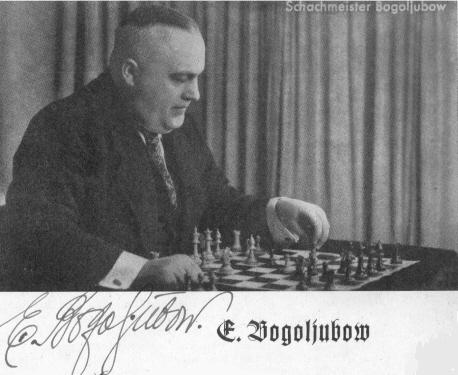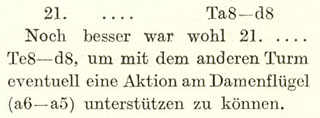Chess Explorations (28)
By Edward Winter
Paulsen v Berger, Berlin, 1881
In C.N. 6265 Johan Van Aelst (Antwerp, Belgium) asked a question about the
game W. Paulsen v J. Berger, Berlin, 1881, which is in various databases as
follows:
1 e4 e5 2 d4 exd4 3 Qxd4 Nc6 4 Qe3 d6 5 Bd2 Be7 6 Bc3 Bf6 7 f4 Qe7 8 Bb5 Bd7
9 Nf3 Nh6 10 Bxf6 Qxf6 11 Nc3 O-O 12 O-O-O Rfe8 13 h3 Qe7 14 g4 f5 15 Bc4+ Be6
16 Nd5 Bxd5 17 Bxd5+ Kh8 18 gxf5 Nxf5 19 Qc3 Ng3 20 Rhe1 Nd8 21 Ng5 Nh5 22 Qf3
Nf6 23 e5 dxe5 24 Rxe5 Qf8 25 Rde1 h6 26 h4 Nc6 27 Bxc6 bxc6 28 Ne6 Qb4 29 c3
Qb6 30 Qg2 Re7 31 Qg6 Rb8 32 R1e2 Qa6 33 Kb1 Nd5 34 Ka1 Qa4
35 Qg4 Rd7 36 Nc5 Nxc3 37 Nxa4 Resigns.
Since 35 Qg4 allows 35...Qd1 mate, our correspondent wondered whether 35 Qg1
was played by White.
In response we suggested that the explanation lies elsewhere. Although the
game also appeared as above on page 23 of a 1997 booklet (published in Olomouc)
on Berlin, 1881, page 166 of the tournament book by E. Schallopp (published
in Leipzig in 1883) presented the conclusion as follows:
White’s 32nd move was given as R5e2, and not R1e2. The full game-score
in Schallopp’s tournament book is:
1 e4 e5 2 d4 exd4 3 Qxd4 Nc6 4 Qe3 d6 5 Bd2 Be7 6 Bc3 Bf6 7 f4 Qe7 8 Bb5 Bd7
9 Nf3 Nh6 10 Bxf6 Qxf6 11 Nc3 O-O 12 O-O-O Rfe8 13 h3 Qe7 14 g4 f5 15 Bc4+ Be6
16 Nd5 Bxd5 17 Bxd5+ Kh8 18 gxf5 Nxf5 19 Qc3 Ng3 20 Rhe1 Nd8 21 Ng5 Nh5 22 Qf3
Nf6 23 e5 dxe5 24 Rxe5 Qf8 25 Rde1 h6 26 h4 Nc6 27 Bxc6 bxc6 28 Ne6 Qb4 29 c3
Qb6 30 Qg2 Re7 31 Qg6 Rb8
32 R5e2 Qa6 33 Kb1 Nd5 34 Ka1 Qa4 35 Qg4 Rd7 36 Nc5 Nxc3 37 Nxa4 Resigns.

Louis Paulsen
Tartakower v Réti, New York, 1924
This position occurred after 21 Rfe1 in Tartakower v Réti, New York, 1924.
Black played a rook to d8, but which rook?
The question was put to us in C.N. 5954 by Charles Sullivan (Davis, CA, USA),
who commented that although various sources, including databases, give the next
move as 21...Rad8, The Book of the New York International Chess Tournament
1924 by A. Alekhine (New York and London, 1925) put ‘KR-Q’ on
page 191 and appended this note on the next page:
‘The queen’s rook stays at its own square in order eventually
to make a demonstration on the queen’s side (P-QR4).’
We noted, though, that page 267 of the German edition of Alekhine’s tournament
book (Berlin and Leipzig, 1925) stated that the move played was 21...Rad8. Alekhine
wrote that moving the king’s rook to d8 would have been an improvement:
Tartakower annotated the game, which he lost, on pages 220-222 of the August
1924 Wiener Schachzeitung. 21...Rad8 was the move given, with an exclamation
mark. We observed that it could therefore be strongly suspected that 21...Red8
in the English edition of the New York, 1924 book was wrong, possibly owing
to a misunderstanding and/or translation error, but that the matter had yet
to be put beyond doubt.
Notwithstanding the quality of Alekhine’s annotations, the book was a
lax production. C.N. 2131 (see page 283 of Kings,
Commoners and Knaves) mentioned that W.H. Watts added a nine-page errata
supplement (to the British edition, of which he was the publisher). The list
sheds no light on the ‘Which rook?’ puzzle but is, of course, indispensable
in connection with any English-language edition of Alekhine’s book. (See
also C.N.s 5954 and 5955.)
In C.N. 6009 David DeLucia (Darien, CT, USA) informed us that he owns Réti’s
score-sheet, which clearly indicates that 21...Rad8 was played. Since that was
also the move given by Tartakower in the Wiener Schachzeitung, it seems
evident that the English-language edition of the tournament book by Alekhine
was wrong.

Richard Réti
Fine v Alexander, Margate, 1937
Björn Frithiof (Almhult, Sweden) asked in C.N. 6112 about the game R.
Fine v C.H.O’D. Alexander, Margate, 1937, which appears as follows in
his database (ChessBase) and on pages 154-155 of Reuben Fine by A. Woodger
(Jefferson, 2004): 1 d4 Nf6 2 c4 e6 3 Nc3 Bb4 4 Qc2 Nc6 5 Nf3 d6 6 a3 Bxc3+
7 Qxc3 O-O 8 b4 e5 9 dxe5 Ne4 10 Qe3 f5 11 Bb2 Nxe5 12 Nxe5 dxe5 13 g3 Be6 14
f3 Nd6 15 Qxe5 Qe7 16 e3 Qf7 17 c5 Nc4 18 Bxc4 Bxc4 19 Kf2 Bb3 20 Bd4 Rae8 21
Qf4 Bd5 22 Be5 Bxf3 23 Bxg7 Bxh1 24 Bxf8 Rxf8 25 Rxh1 Qa2+ 26 Kf1 Qxa3 27 Kg2
Qb2+ 28 Kh3 Qe2 29 Rf1 Qg4+ 30 Kg2 Re8
31 Qxf5 Qxb4
32 Rf4 Qd2+ 33 Kh3 Qxe3 34 Qd7 Qe7 Drawn.
Our correspondent commented:
‘What puzzles me is the conclusion of the game, after 31...Qxb4.
White is said to have played 32 Rf4 (instead 32 Qf7+, which wins at once),
and after the further moves 32...Qd2+ 33 Kh3 Qxe3, White had an immediate
win with 34 Rg4+.’
In reply we expressed the belief that White’s 31st move was mistranscribed
as Qxf5 instead of Qxc7, i.e. QxKBP rather than QxQBP. The move was given as
31 QxQBP on page 304 of the June 1937 BCM and on pages 51-52 of The
best games of C.H.O’D. Alexander by Harry Golombek and Bill Hartston
(Oxford, 1976).

Reuben Fine
Bogoljubow v Rellstab, Poland, 1940
C.N. 5718 thanked Ed Hamelrath (Memphis, TN, USA) for raising the subject of
the 1940 game between Bogoljubow and Rellstab, as given on pages 199-200 of
107 Great Chess Battles by A. Alekhine (Oxford, 1980):
1 d4 Nf6 2 Nf3 b5 3 Bg5 Bb7 4 e3 a6 5 Nbd2 e6 6 a4 b4 7 Bd3 c5 8 O-O Be7 9
dxc5 Bxc5 10 e4
10...Be7 (Alekhine appended a question mark to this move and wrote, in our
translation in the above-mentioned book: ‘It was absolutely essential
to play 10…d6 although White would have obtained the advantage in any
case by 11 e5 dxe5 12 Nxe5 Qd4 13 Nef3 Qd7 14 Re1 O-O 15 c4 bxc3 16 bxc3, followed
by 17 Qc2 and 18 Rad1.’) 11 e5 Nd5 12 Bxe7 Nxe7 13 Nc4 Nc8 14 Re1 d5 15
exd6 Nxd6 16 Bg6 hxg6 17 Nxd6+ Ke7 18 Nxb7 Qc7 19 Qd5 Rh5 20 Qe4 Nc6 21 g4 Resigns.
Mr Hamelrath commented that, in the note cited, 15 c4 allows Black the simple
win of a piece with 15…Qxd3.
The game was taken from pages 249-251 of Alekhine’s posthumous book Gran
Ajedrez (Madrid, 1947), where White’s 13th move in Alekhine’s
variation appeared merely as ‘13 C3A’, with no mention of whether
it was the knight on e5 or on d2 that went to f3. In the light of our correspondent’s
remark it seems evident that we should have given the move as 13 Ndf3, and not
13 Nef3. Alekhine’s note contained ‘13 Ndf3’ on page 231 of
Bogoljubow – The Fate of a Chess Player by Sergei Soloviov (Sofia,
2004), although here too there is a complication: Black’s reply was specified
as 13...Qd5, and not 13...Qd7 as in Gran Ajedrez.
C.N. 5718 discussed
the uncertainty over the occasion of the game, our tentative conclusion being
that Warsaw, rather than Cracow, was the venue. The tournament took place in
late 1940 in Cracow, Krynica and Warsaw.

Efim Bogoljubow
Submit information
or suggestions on chess explorations
All ChessBase articles
by Edward Winter
 Edward
Winter is the editor of Chess
Notes, which was founded in January 1982 as "a forum for aficionados
to discuss all matters relating to the Royal Pastime". Since then, over 6,300
items have been published, and the series has resulted in four books by Winter:
Chess
Explorations (1996), Kings,
Commoners and Knaves (1999), A
Chess Omnibus (2003) and Chess
Facts and Fables (2006). He is also the author of a monograph
on Capablanca (1989).
Edward
Winter is the editor of Chess
Notes, which was founded in January 1982 as "a forum for aficionados
to discuss all matters relating to the Royal Pastime". Since then, over 6,300
items have been published, and the series has resulted in four books by Winter:
Chess
Explorations (1996), Kings,
Commoners and Knaves (1999), A
Chess Omnibus (2003) and Chess
Facts and Fables (2006). He is also the author of a monograph
on Capablanca (1989).
Chess Notes is well known for its historical research, and anyone browsing
in its archives
will find a wealth of unknown games, accounts of historical mysteries, quotes
and quips, and other material of every kind imaginable. Correspondents from
around the world contribute items, and they include not only "ordinary readers"
but also some eminent historians – and, indeed, some eminent masters. Chess
Notes is located at the Chess
History Center. Signed copies of Edward Winter's publications are
currently available.






























 Edward
Winter is the editor of
Edward
Winter is the editor of 




